 |
 |
 |
| |
VX-950 HCV Protease Inhibitor Resistance Profile: combination therapy suppresses drug resistance
|
| |
| |
Reported by Jules Levin
AASLD, Oct 27-31, 2006, Boston, MA
Brief Summary: Tara Keiffer from Vertex presented an oral talk at AASLD on VX-950 drug resistance and how to prevent resistance. She presented an analysis of patients who received VX950 in a 14-day study. The goal of this sub-study analysis was to identify VX950 resistant variants (mutations) and the kinetics of their emergence (selection) in patients dosed with VX950 or VX950+Pegasys. They used a highly sensitive clonal method to characterize the mutations (viral variants), and they also did a phenotypic analysis. VX-950 has demonstrated a rapid & profound viral load reduction; drug resistance mutations can emerge when VX950 is given alone (as monotherapy), as sequence changes (mutations) in the HCV genome occur spontaneously & frequently as a natural result of the high levels of replication of the HCV virus-pre-existing mutations are likely present at a low level prior to drug treatment; but, resistant HIV and wild-type HCV (non-resistant virus) were suppressed & became undetectable with Pegasys added in combination therapy. With continued use of Pegasys+Ribavirin, after VX950 was stopped in the short-term study of VX950, wild-type & resistant HCV were suppressed & became or remained undetectable.
Telaprevir, also known as VX-950, is an oral HCV protease inhibitor, which has been previously shown in study to reduce HCV RNA by 4.4 logs as monotherapy and by 5.5 logs in combination with peginterferon in patients with HCV genotype 1.
In early studies there has been some patients whose viral load rebounded on VX950 monotherapy. I have reported from EASL in the Spring 2006 where Vertex reported this information on the development of resistance mutations: low-level resistance (< 25-fold increase in 50% inhibitory concentration): V36M/A, T54A, R155K/T, A156S; high-level resistance (> 50-fold increase in 50% inhibitory concentration): A156V/T, V36M/A + R155K/T, V36M/A + A156V/T
Tara Keiffer from Vertex, reported on a sub-study at AASLD an analysis to display the emergence & kinetics of VX950 HCV protease mutations when dosed with VX950 alone or in combination with Pegasys. Using sensitive methods to identify & characterize resistant variants she showed that although VX-950 produces dramatic HCV RNA suppression over 14-day course of treatment either alone or in combination with peginterferon alfa-2a, viruses with VX950 resistance mutations emerged as wild-type virus was cleared. Keiffer, however, reported that subsequent peginterferon alfa-2a/ribavirin therapy suppressed VX950 resistant virus to undetectable levels.
The presentation by Keiffer was an analysis from patients with genotype 1 who received treatment for 14 days with VX950. Patients received 750 mg 3 times per day (n=8), or VX950 750 mg 3 times per day plus Pegasys (n=8).
Here is Keiffer's presentation--
"Combination of Telaprevir (VX-950) andPeg-IFN-alfa Suppresses Both Wild-type Virus andResistance Variants in HCV Genotype 1-Infected Patients in a 14-day Phase 1b study"
1Vertex Pharmaceuticals, Cambridge, MA, USA2Saarland University Hospital, Homburg/Saar, Germany 3Academic Medical Center, Amsterdam, The Netherlands Tara Kieffer1, C Sarrazin2,J Miller1, S Traver2, Yi Zhou1, D Bartels1, B Hanzelka1,U Mu_h 1, Yi Zhou1, C Lin1, H Reesink3,A Kwong1, S Zeuzem2
American Association for the Study of Liver Diseases: Boston, MA (October 30, 2006).
Outline of Talk
-- Drug resistance in HCV: key points
-- Identification and characterization of resistant variants using sensitive methods
--Suppression of resistant variants by thecombination of telaprevir and peg-interferon in a clinical trial
Evolution of Viral Drug Resistance
Sequence changes (mutations) in the HCV genome occurspontaneously and frequently as a natural result of viral replication:
-- HCV polymerase has a high error rate (-1 mistake/virion)
--High rate of HCV replication (-1012 virions produced each day)
Therefore, variants with mutations conferring resistance to a specifically targeted antiviral most likely exist at a low frequency prior to drug treatment:
-- Resistant variants tend to be less fit than wild-type and therefore may not be detected.

Evolution of Viral Drug Resistance
Drug-resistant variants pre-exist and are selected bydrug pressure
Any specifically-targeted antiviral therapy (STAT) withsufficient potency will select for drug-resistant virus (e.g.: HIV, HBV, and HCV)
-- Sufficient inhibition of wild-type virus is required for emergence of these variants
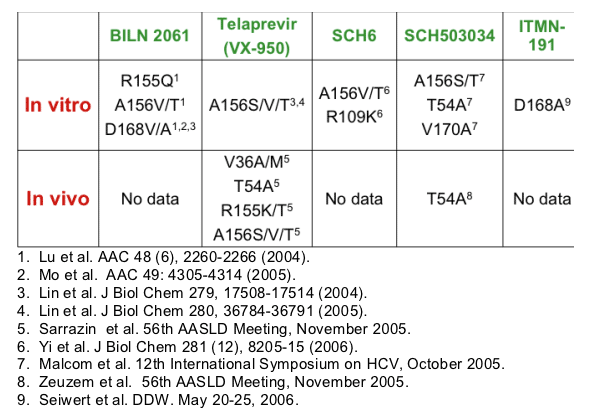
Preventing the Emergence of Drug Resistance Variants
Telaprevir has demonstrated a rapid and profound reduction in HCVRNA in genotype 1 infected patients
Clinical breakthrough associated with resistant variants was seen insome patients dosed with telaprevir alone
-- Exogenous IFN may suppress the emergence of resistant variants
-- IFN is active against telaprevir-resistant variants in vitro
Only low levels of telaprevir-resistant variants are present initially
Telaprevir + Peg-IFN-_2a prevented the breakthrough of resistant variants in clinical trials
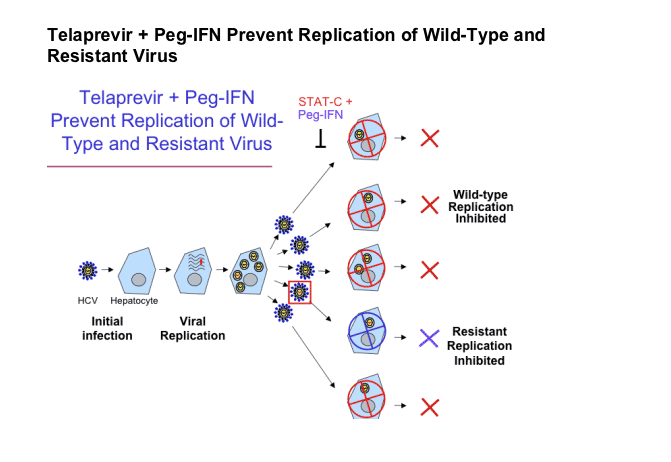
VX05-950-103: first study of telaprevir incombination with pegylated interferon
20 patients
-- Hepatitis C Virus, genotype 1
-- Chronically infected
-- Treatment-naive
Study dosing period was 14 days
-- Peg-IFN-_2a weekly (n=4)
-- Telaprevir (750 mg q8h) (n=8)
-- Telaprevir (750 mg q8h) plus Peg-IFN-_2a weekly (n=8)
At the completion of study dosing, Peg-IFN-_2a (Pegasys) and RBV was provided for all subjects (off-study).
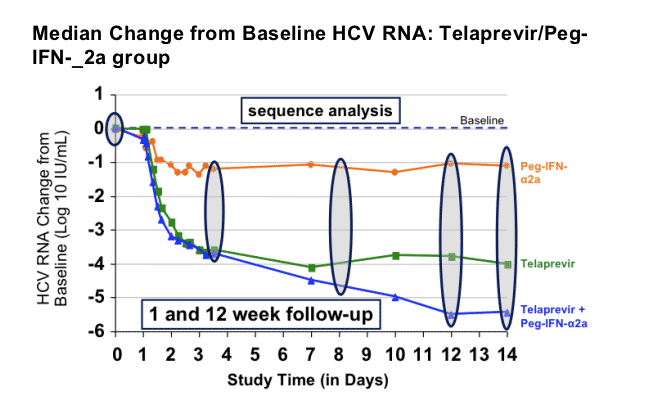
Characterization of Viral Variants During and After Telaprevir Dosing
The goal of this sub-study--
Identify telaprevir-resistant variants and the kinetics of their selection in patients dosed with:
-- Telaprevir alone
-- Telaprevir + Peg-IFN-_2a
To determine whether variants persist during Peg-IFN and RBV treatment after the 14-day telaprevir dosing period
Highly Sensitive Clonal Method For CharacterizingViral Variants During Antiviral Therapy
Analyses of HCV NS3 Protease (amino acids 1-181)
Detects variants present at -5% frequency
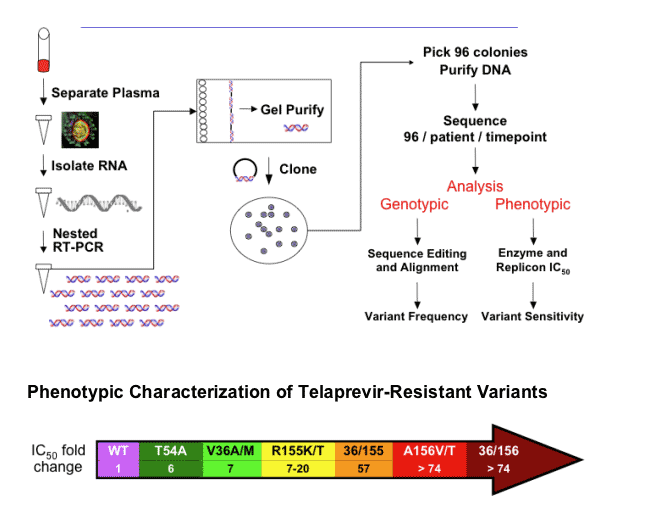
<25-fold increase in replicon IC50 from wild-type
-- V36A/M, T54A, R155K/T, A156S
--Mild impairment of fitness (rate of replication)
>50-fold increase in replicon IC 50 from wild-type
-- A156V/T, V36A/M-R155K/T, V36A/M-A156V/T
-- Marked impairment of fitness (rate of replication)
1. C. Sarrazin et al. 56th AASLD Meeting, November 2005.
2. T. Kieffer et al. 41st EASL Meeting, April 2006.
3. Y. Zhou et al. 13th International Symposium on HCV and Related Viruses, August 2006.
VX05-950-103 : Antiviral Response Groups
Telaprevir (750 mg q8h) alone
-- Break-through (n=4)
-- Continued inhibition (n=4)
Telaprevir (750 mg q8h) + Peg-IFN-_2a weekly
-- Continued inhibition (n=8)
Follow-on Peg-IFN-_2a + RBV dosing
-- Continued inhibition (n=15) through week 12
-- Undetectable (n=15) at week 24
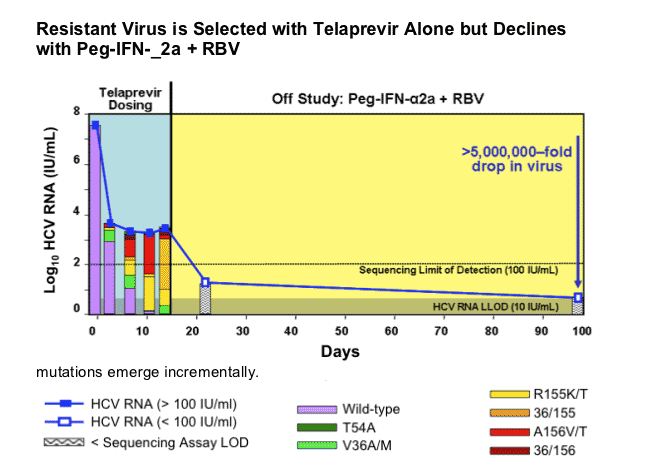
VX05-950-103 : Antiviral Response Groups
Telaprevir (750 mg q8h) alone
-- Break-through (n=4)
-- Continued inhibition (n=4)
Telaprevir (750 mg q8h) + Peg-IFN-_2a weekly
-- Continued inhibition (n=8)
Follow-on Peg-IFN-_2a + RBV dosing
-- Continued inhibition (n=15) through week 12
-- Undetectable (n=15) at week 2
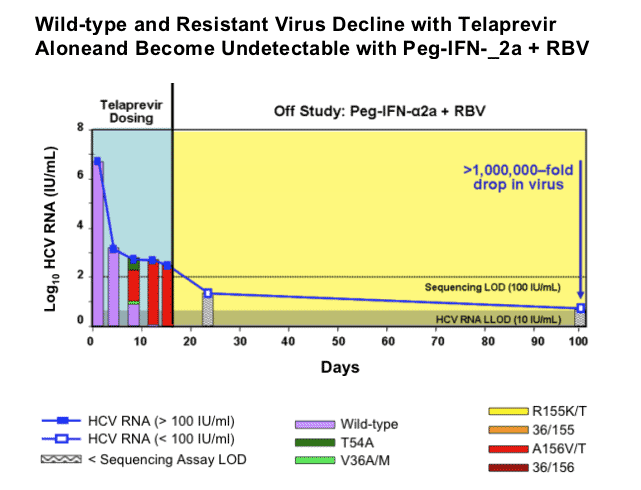
VX05-950-103 : Antiviral Response Groups
Telaprevir (750 mg q8h) alone
-- Break-through (n=4)
-- Continued inhibition (n=4)
Telaprevir (750 mg q8h) + Peg-IFN-_2a weekly
-- Continued inhibition (n=8)
Follow-on Peg-IFN-_2a + RBV dosing
-- Continued inhibition (n=15) through week 12
-- Undetectable (n=15) at week 24
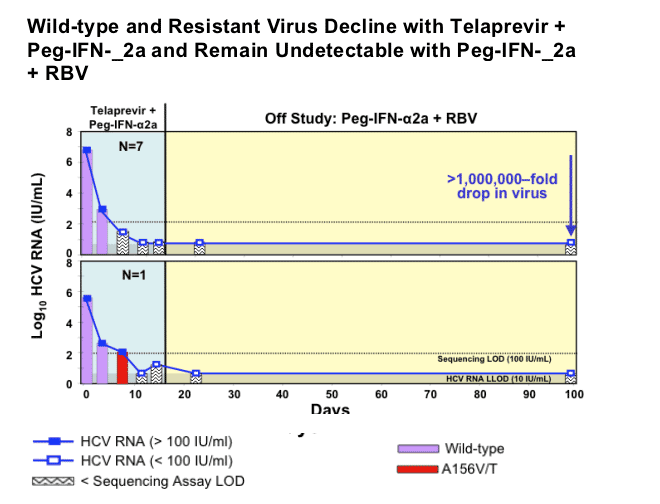
VX05-950-103 : Antiviral Response Groups
Telaprevir (750 mg q8h) alone
Break-through (n=4)
Continued inhibition (n=4)
Telaprevir (750 mg q8h) + Peg-IFN-_2a weekly
--Continued inhibition (n=8)
Follow-on Peg-IFN-_2a + RBV dosing
-- Continued inhibition (n=15) through week 12
-- Undetectable (n=15) at week 24
Investigators have continued to follow these patients and results are presented at Poster #1142(Forestier et al.) My next report.
|
| |
|
 |
 |
|
|